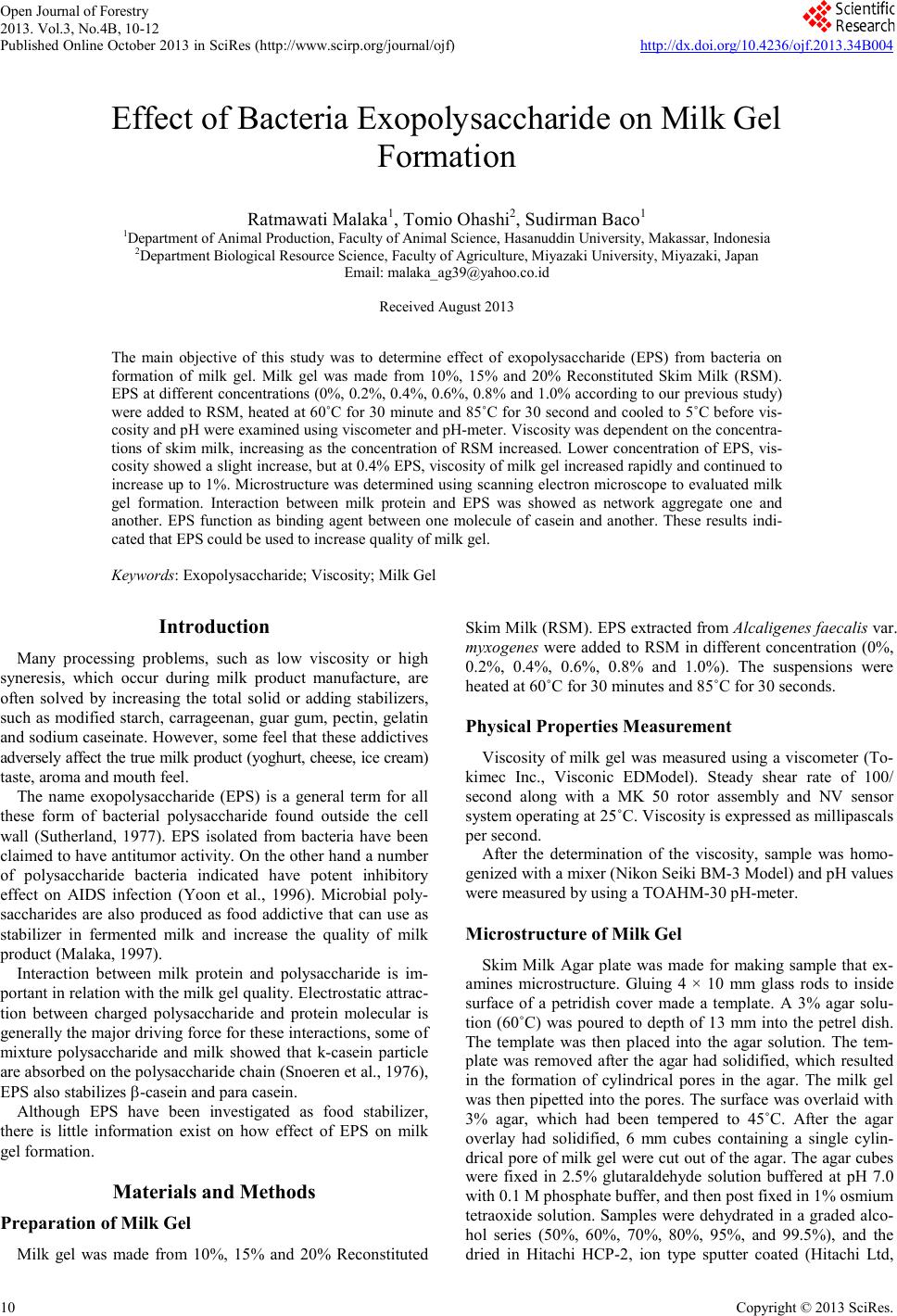
Open Journal of Forestry
2013. Vol.3, No.4B, 10-12
Published Online October 2013 in SciRes (http://www.scirp.org/journal/ojf) http://dx.doi.org/10.4236/ojf.2013.34B004
Copyright © 2013 SciRes.
Effect of Bacteria Exopolysaccharide on Milk Gel
Formation
Ratmawati Malaka1, Tomio Ohashi2, Sudirman Baco1
1Department of Animal P roduction, Faculty of Animal Science, Hasanuddin University, Makassar, Indonesia
2Department Biological Resource Science, Faculty of Agriculture, Miyazaki University, Miyazaki, Japan
Email: malaka_ag39@yahoo.co.id
Received August 2013
The main objective of this study was to determine effect of exopolysaccharide (EPS) from bacteria on
formation of milk gel. Milk gel was made from 10%, 15% and 20% Reconstituted Skim Milk (RSM).
EPS a t different c oncentr ations (0%, 0. 2%, 0.4%, 0.6% , 0.8% and 1.0 % accordi ng to our previo us study)
were added t o RSM, heated at 60˚C for 30 minute a nd 85˚C for 30 second a nd cooled to 5˚C before vis-
cosi t y and pH w ere examined us i ng visc o meter a nd p H-meter . V is c osity was dep ende nt on th e c onc entr a-
tions of skim milk, increasing as the concentration of RSM increased. Lower concentration of EPS, vis-
cosi ty showed a slight incr ease, but a t 0.4% EP S, viscos ity of mil k gel inc reas ed rapi dly and conti nued to
incr ease up to 1%. Mic rostructur e was det ermined using sc anning ele ctron micr oscope to evalua ted milk
gel formation. Interaction between milk protein and EPS was showed as network aggregate one and
another. EPS function as binding agent between one molecule of casein and another. These results indi-
cated that EPS could be used to increase qua lity of milk gel.
Key words: Exopol ysaccharide; Viscosity; Milk Gel
Introduction
Many processing problems, such as low viscosity or high
syneresis, which occur during milk product manufacture, are
often solved by increasing the total solid or adding stabilizers,
such as mod ified starch, carrageenan , guar gum, pectin , gelatin
and sodium caseinate. Ho wever, so me feel th at thes e addict ives
adver sely a ffect th e true milk pro duct (yoghur t, ch eese, i ce cre am)
taste, aroma and mouth feel.
The name exopolysaccharide (EPS) is a general term for all
these form of bacterial polysaccharide found outside the cell
wall (Sutherland, 1977). EPS isolated from bacteria have been
claimed to have an titumor acti vity. On the other hand a number
of polysaccharide bacteria indicated have potent inhibitory
effect on AIDS infection (Yoon et al., 1996). Microbial poly-
saccharides are also produced as food addictive that can use as
stabilizer in fermented milk and increase the quality of milk
product (Malaka, 1997).
Interaction between milk protein and polysaccharide is im-
portant in relation with the milk gel quality. Electrostatic attrac-
tion between charged polysaccharide and protein molecular is
generally the major drivi ng force fo r th ese in teract io ns, some of
mixture polysaccharide and milk showed that k-casein particle
are absorbed on the polysaccharide ch ain (Sno eren et al., 1976),
EPS also stabilizes β-casein and para casein.
Although EPS have been investigated as food stabilizer,
there is little information exist on how effect of EPS on milk
gel formation.
Materials and Methods
Preparation of Milk Gel
Milk gel was made from 10%, 15% and 20% Reconstituted
Skim Milk (RSM). EPS extracted from Alcalig enes fa ecalis var.
myxogenes were added to RSM in different concentration (0%,
0.2%, 0.4%, 0.6%, 0.8% and 1.0%). The suspensions were
heated at 60˚C for 30 minutes and 85˚C for 30 seconds.
Physical Properties Measurement
Viscosity of milk gel was measured using a viscometer (To-
kimec Inc., Visconic EDModel). Steady shear rate of 100/
second along with a MK 50 rotor assembly and NV sensor
system operating at 25˚C. Visco sity is exp ress ed as millip ascals
per second.
After the determination of the viscosity, sample was homo-
genized with a mixer (Nikon Seiki BM-3 Model) and pH values
were measured by using a TOAHM-30 pH-meter.
Microstructure of Milk Gel
Skim Milk Agar plate was made for maki ng sample that ex-
amines microstructure. Gluing 4 × 10 mm glass rods to inside
surface of a petridish cover made a template. A 3% agar solu-
tion (60˚C) was poured to depth of 13 mm into the petrel dish.
The template was then placed into the agar solution. The tem-
plate was removed after the agar had solidified, which resulted
in the formation of cylindrical pores in the agar. The milk gel
was then pipetted into the pores. The surface was overlaid with
3% agar, which had been tempered to 45˚C. After the agar
overlay had solidified, 6 mm cubes containing a single cylin-
drical po re of milk gel were cut ou t of the agar. The agar cubes
were fixed in 2.5% glutaraldehyde solution buffered at pH 7.0
with 0.1 M phosphate buffer, and then post fixed in 1% osmium
tetraoxi de solution. Samples wer e dehydrated i n a graded alco-
hol series (50%, 60%, 70%, 80%, 95%, and 99.5%), and the
dried in Hitachi HCP-2, ion type sputter coated (Hitachi Ltd,